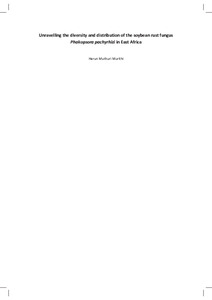| dc.description.abstract | Soybean is an important legume crop that is cultivated worldwide on more than 120 million hectares, producing more than 330 million tonnes of soybeans annually. Soybeans contain 40% of protein and 20% of oil and the crop is therefore used both for human and livestock consumption. Generally, soybean has the potential to significantly improve the nutrition of the inhabitants of sub-Saharan Africa. Soybean production has intensified in Africa over the past 15 years, owing to the raising demand driven by a population increase and a desire for diversification of diets. In addition, soybean cultivation contributes to increased economic opportunities and higher living standards for farmers. However, soybean yields in Africa on average range between 0.8 to 1.2 tonnes/ha, while the potential of the crop can be as high as 4 tonnes/ha. The relatively poor yields can largely be attributed to abiotic factors (soil fertility, drought, poor nodulation) as well to as biotic ones (diseases and insect pests).
Rust caused by the biotrophic fungus Phakopsora pachyrhizi is a major threat to soybean cultivation, as it can cause up to 80% yield loss. The fungus is widely spread and found in most soybean-producing regions worldwide. Unfortunately, no rust-resistant soybean cultivars are commercially available yet. However, eventually the use of resistant cultivars is the preferred option for disease control, as the use of fungicides is expensive and it complements other disease management strategies. The development of resistant cultivars requires a comprehensive understanding of the prevalent P. pachyrhizi pathotypes in different geographic regions. In this thesis research, the aim was to gain more insight into P. pachyrhizi diversity and distribution in East Africa, in order to guide the design and deployment of proper disease management strategies.
Chapter 1 is an introduction to the work described in this thesis and puts forward the importance of soybean as a crop and provides a biological background of the biotrophic soybean rust fungus P. pachyrhizi. The chapter presents mechanisms that operate in soybean-pathogen interactions, highlighting the major Rpp (for resistance to P. pachyrhizi) genes that have been characterized and our knowledge on virulence diversity among African P. pachyrhizi isolates. The chapter also presents an outline of the thesis.
Chapter 2 is a review on the economic importance of soybean as a crop, highlighting soybean rust as a major constraint for global soybean production. The epidemiology of the soybean rust fungus is described and the global status of the pathogen virulence spectrum is discussed. Furthermore, the review highlights some of the on-going research efforts in eastern Africa to identify effective soybean rust disease control measures.
In Chapter 3, the diversity of the various P. pachyrhizi isolates collected in East Africa and from other continents is compared. Our study identified four distinct pathotypes among the isolates from East Africa. The isolates that were virulent on most resistance genes originated from Argentina and South Africa. Among the Rpp genes, four (Rpp1b, Rpp2, Rpp3 and Rpp5) were identified as resistant to most of the isolates tested in this study, and therefore these are candidates for deployment in breeding programs in Africa.
Chapter 4 investigates the diversity and distribution of P. pachyrhizi pathotypes in East Africa. A set of 11 host differentials carrying specific (combinations of) resistance genes was used to determine the pathotypes present among 65 P. pachyrhizi isolates and their distribution over four countries in East Africa. Twelve pathotypes were identified that were virulent on soybean genotypes carrying Rpp1 and avirulent on cultivars carrying Rpp1b, Rpp2 or Rpp3, as well as on a cultivar that contains Rpp2, Rpp4 and Rpp5.
In Chapter 5, soybean accessions were evaluated for resistance to P. pachyrhizi. To this end, 77 soybean accessions from both local and international sources were evaluated at multiple locations in Tanzania and Uganda in 2016 and 2017. Infection types, disease severities and sporulation levels varied among the accessions and locations. The majority of accessions displayed tan-coloured (TAN) lesions and developed moderate sporulation, implying susceptibility, while a handful of accessions showed a low disease severity and displayed reddish brown (RB) lesions, signifying resistance. We identified seven accessions that appeared most resistant to rust in most locations over the two years, and these may provide useful material for further study and, ultimately, rust management.
In Chapter 6, a comparative transcriptome analysis was conducted for P. pachyrhizi isolates that have different virulence patterns on a set of soybean cultivars carrying specific (combinations of) resistance genes. The transcriptomes of ten different isolates were compared using RNA-Seq, and candidate avirulence proteins matching the different soybean Rpp genes were identified. Collectively, a total of 7,061 secreted protein sequences were predicted for the ten isolates, putatively containing effector proteins. Once confirmed, Avrs can be used for assessing the recognition specificities of resistance genes and other effectors can be used to screen for novel recognition specificities.
Chapter 7 discusses the major findings of this thesis research and relates these to findings from previous studies on P. pachyrhizi. Furthermore, research gaps that require further investigations are identified. |

